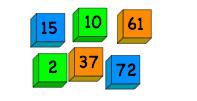Or search by topic
Number and algebra
Geometry and measure
Probability and statistics
Working mathematically
Advanced mathematics
For younger learners
That Number Square



- Problem
- Getting Started
- Student Solutions
- Teachers' Resources
That Number Square!

When you arrive in the classroom one morning you discover all the numbers have fallen off the class number square and they are in a heap on the floor. All that is left on the wall is a blank grid!
There are five minutes to go before the first lesson starts.
Your challenge is to find a quick way of putting the numbers back in their right places on the grid.
Where will you start?
You might find it helpful to print out a blank grid and number tiles to cut out.
Once you have had chance to think about how you will put the numbers in place, talk to some of your friends about what they would do.
Or, you could click below to see how some other children got started on this challenge.
Omar and Isla said:
We started with the tens column, counting in tens.
Julia and Chris said:
We started along the top row. We filled in 1 to 10, then you can fill in each column by adding 10 more each time.
Michaela and Nathan said:
We counted in ones because we can do this super-fast!
You could try each of these starting points.
What would you do next? Would this be a quick way for you to put the hundred square back together?
Is there a way of making the hundred square that you think is a particularly 'good' way?
Why? What makes it a 'good' way?
Why do this problem?
This activity also offers an opportunity to discuss the strategies that children come up with - what is a good strategy for putting the number tiles back in the correct places as quickly as possible? What makes one strategy 'better' than another?
Possible approach
Print and cut out the number tiles and blank grid, leaving out either the 0 tile or the 100 tile. Alternatively, you may have your own sets of blocks, tiles or cards that the children could use. Explain the task and, without saying anything more, invite learners to try getting started in pairs. As they work, walk around and observe how they set about the task.
After a little while, discuss different approaches together, drawing on what you have observed. For example:
- Did you try and place the first tile in the random pile on the floor on the number grid first? If so, how did you decide where to put it?
- Or did you sift through the number tiles to find one that you know exactly where to place on the number grid?
- Which one did you choose? Why that one?
- Were there any key number tiles to get in place on the number grid that help you place the rest? What is special about those 'key' tiles?
You may also choose to discuss the starting points offered in the problem itself.
Ask children to devise some good strategies between them, and then encourage them to experiment with different approaches to see which ones help them put the number tiles back as fast as possible. You may find that different children find different strategies useful. Challenge them to articulate how they know where to put a particular number tile. Encourage explanations that focus on pattern, place value and multiples.
Key questions
Possible extension
What happens if it is a 50 - 149 number square, for example?
Can you use the same strategies?
What happens if the number square is not 10 by 10 but only 6 squares wide, for example?
How do you know where to place the number tiles now?
Which widths of number square are harder/easier than the 10 by 10 grid?
Possible support
You may like to give some children a number grid where some numbers remain. Some children could work with the number grid up to 50 or up to 30. Working with a partner gives children the opportunity to discuss where to place a number, and why.
You may also like
Writing Digits
Lee was writing all the counting numbers from 1 to 20. She stopped for a rest after writing seventeen digits. What was the last number she wrote?
Six Is the Sum
What do the digits in the number fifteen add up to? How many other numbers have digits with the same total but no zeros?

